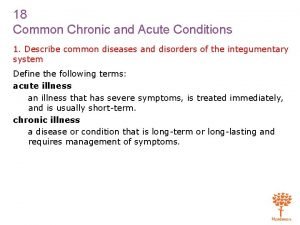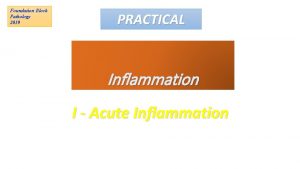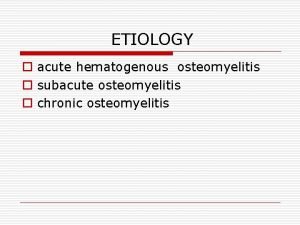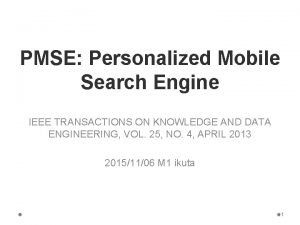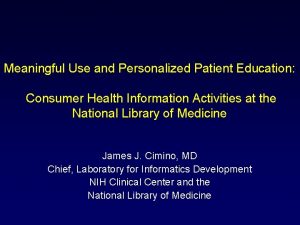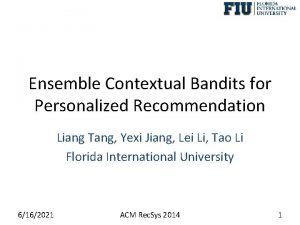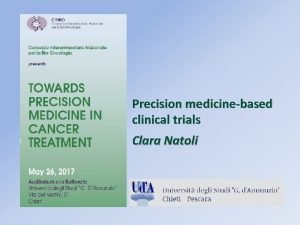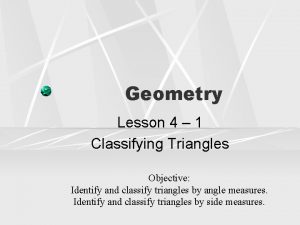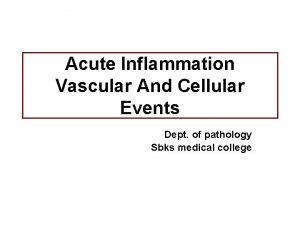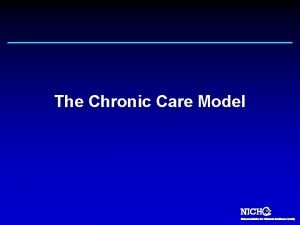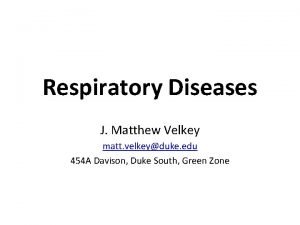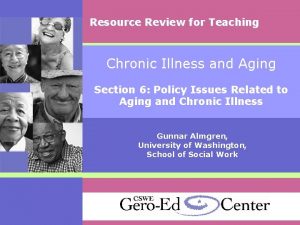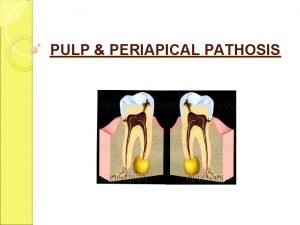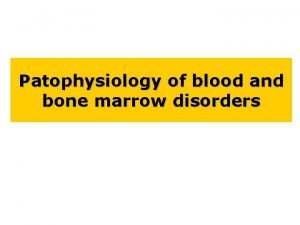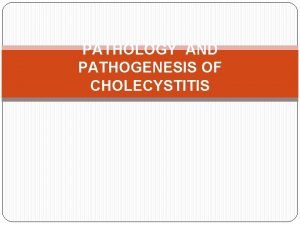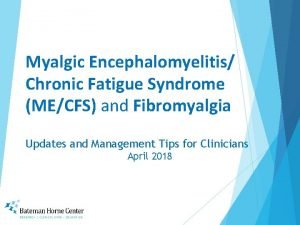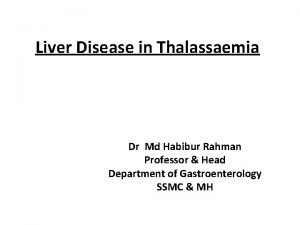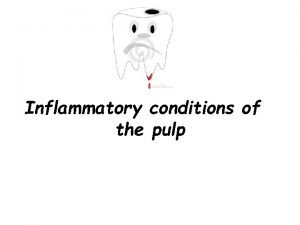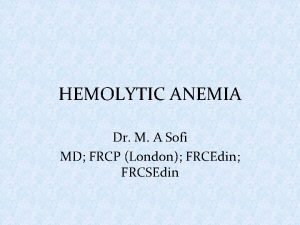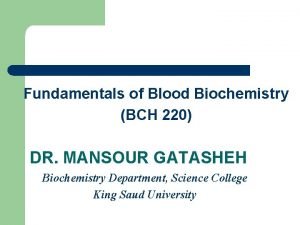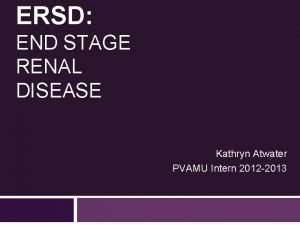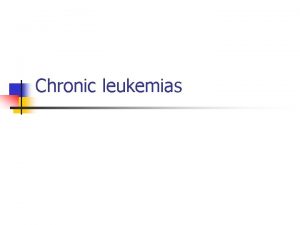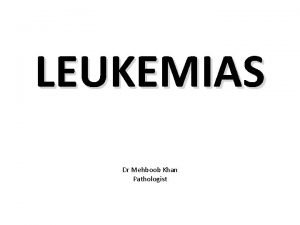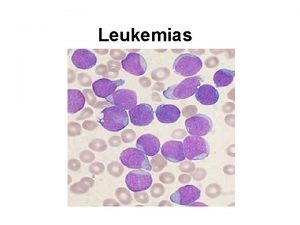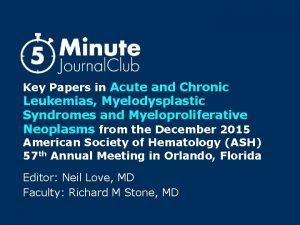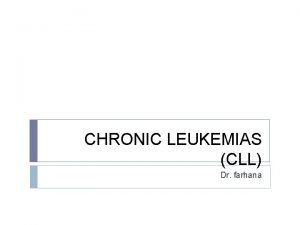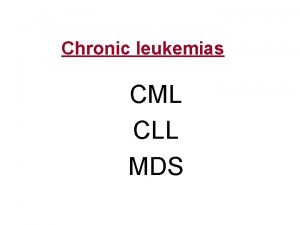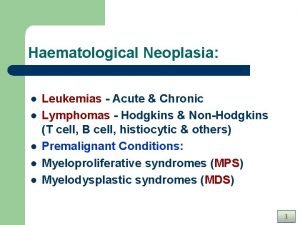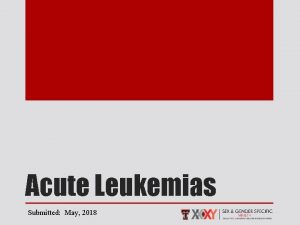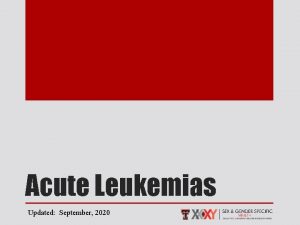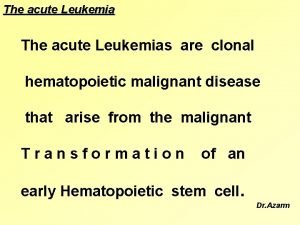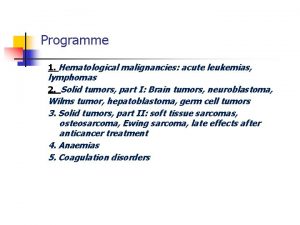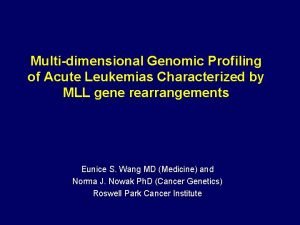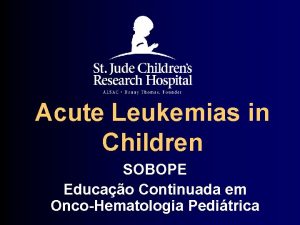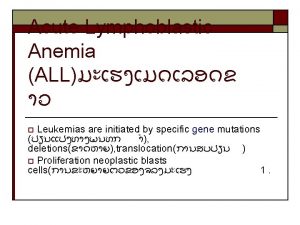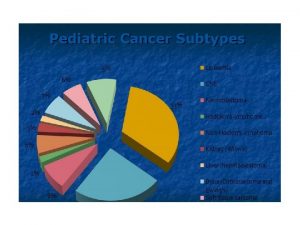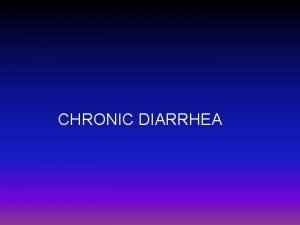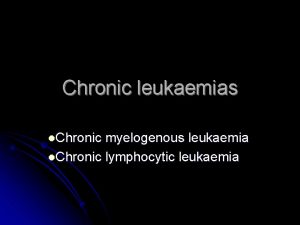110314 Personalized Approach in Acute and Chronic Leukemias























































- Slides: 55

11/03/14 Personalized Approach in Acute and Chronic Leukemias Emmanuel C. Besa, M. D. Professor of Medical Oncology Hematologic Malignancies

The Perfect Storm in Hematologic Malignancy in Acute and Chronic Leukemias • Discovery of the Philadelphia Chromosome as a specific diagnostic marker led to its molecular mechanism in Chronic Myelogenous Leukemia (CML) • Translocation led to discovery of BCR-ABL translocation gene which proved to be pathogenetic fusion protein (tyrosine kinase) • Designed tyrosine kinase inhibitor (TKI) imatinib blocks specific protein results in reversing CML at the molecular level • Change the natural course of the disease resulting in possible cure and eliminating risky bone marrow transplantation as only curative therapy.


Philadelphia Chromosome Translocation in CML Results in BCR-ABL Oncogene 9 9 Ph 22 q 22 Translocation BCR ABL Transcription and translation BCR-ABL fusion protein Inhibition by TKI Constitutive tyrosine kinase Phosphorylation of multiple substrates Mitogenic signaling and genomic instability increased Apoptosis and stromal regulation decreased CML ▪ Stem cell disorder ▪ Characterized by myeloproliferation ▪ Well-described clinical course

Natural Course of CML Accumulation of immature myeloid cells New cytogenetic changes Chronic Phase Accelerated Phase Blast Phase If untreated, 3 -5 yrs Varies Median survival of several mos Prognosis Responsive to treatment Decreased responsiveness Resistant to treatment Symptoms Asymptomatic OR Fatigue Weight loss Abdominal pain or discomfort Night sweats Progressive splenomegaly Myelofibrosis Bleeding complications Infection complications Duration Radich JP, et al. Proc Natl Acad Sci U S A. 2006; 103: 2794 -2799. Sawyers CL. N Engl J Med. 1999; 340: 1330 -1340. Druker B, et al. Chronic leukemias. In: Cancer, principles, and practice of oncology. 17 th ed. 2005.

Diagnosis of CML Sensitivity Hematologic Cytogenetic Karyotype (Ph chromosome) Peripheral blood (with myeloid cells) Bone marrow (with myeloid hyperplasia) Courtesy of Neil Shah, MD, Ph. D. Chromosomal translocation t(9; 22)(q 34; q 11) Molecular FISH PCR (BCR-ABL fusion) Abnormal BCR-ABL Red: BCR Green: ABL Yellow: fusion Abnormal BCR-ABL Lane 1: BCR-ABL+ Lane 2: BCR-ABL-

Criteria for Hematologic, Cytogenetic, and Molecular Response Criteria Complete hematologic response ▪ ▪ ▪ Complete normalization of PB counts, leukocyte count < 10 x 109/L Platelet count < 450 x 109/L No myelocytes, promyelocytes, or blasts in PB No palpable splenomegaly No disease symptoms Cytogenetic response ▪ Complete No Ph+ metaphases ▪ Partial 1% to 35% Ph+ metaphases ▪ Major 0% to 35% Ph+ metaphases (complete + partial) ▪ Minor > 35% Ph+ metaphases Molecular Response ▪ Major ≥ 3 log reduction in BCR-ABL m. RNA or BCR-ABL/ABL ≤ 0. 1% by QPCR (International Scale) ▪ Complete (CMR or MR 4. 5) No detectable BCR-ABL m. RNA using assay with sensitivity at least 4. 5 logs below standardized baseline NCCN. Clinical practice guidelines in oncology: chronic myelogenous leukemia. v 3. 2014.


Imatinib Changed the Therapeutic Landscape for Patients With Ph+ CML Best available therapy 5 -Yr OS, % Imatinib* IFN-α or SCT + † second-line ‡ imatinib IFN-α or SCT 63 IFN-α Hydroxyurea Busulfan 1. 0 Survival Probability (All Ph+ CML Disease Phases) 0. 9 2002 -2008, imatinib* 0. 8 2010 93 71 53 46 38 2000 0. 7 1997 -2008, IFN-α or SCT† plus second-line imatinib 0. 6 1990 0. 5 1995 -2008, IFN-α or SCT 0. 4 ‡ 1980 0. 3 1986 -2003, IFN-α 0. 2 1983 -1994, hydroxyurea 1970 0. 1 1983 -1994, busulfan 0 0 2 4 6 8 10 12 Yrs After Diagnosis † ‡ *CML IV. CML IIIA. CML III. 14 16 18 20 22 1960

IRIS 8 -Yr Update: OS (ITT) With Imatinib Treatment in CML 100 80 OS (%) 60 Estimated OS at 8 yrs: 85% (93% considering only CML-related deaths) 40 20 0 0 12 24 36 48 60 72 Mos Since Randomization Deininger M, et al. ASH 2009. Abstract 1126. 84 96 108



Acute Promyelocytic Leukemia (M-3) • A) a severe bleeding tendency due to fibrinogenopenia and disseminated intravascular coagulation • (B) accumulation of abnormal promyelocytes in bone marrow and chromosomal translocation t(15; 17)(q 22; q 21) • (C) with the resultant fusion transcripts between PML and RAR detected by FISH using PML-RAR dualcolor, dual-fusion translocation probes • D) Schematics representing the formation of 15; 17 reciprocal chromosomal translocations and fusion transcripts

Mechanism of DIC in APL

Reversal of Coagulopathy by differentiation with ATRA or ATO

Mechanism of Action ATRA

Mechanism of ATRA for reversal of DIC & induce Retinoid Syndrome

Differentiation Syndrome due to Increased Cytokines (Cytokine Storm) • High WBC counts as leukemic cells differentiates promotes expressions of one or more adhesion molecules with high incidence of vascular complications and early mortality • Clinical features of Retinoid syndrome are: - unexplained fever, - weight gain, - respiratory distress, - interstitial pulmonary infiltrates, - pleural and pericardial effusions, - episodic hypotension - acute renal failure.

Special supportive care during induction of APL • Once APL is suspected by morphology or presence of DIC the patient should be treated as an emergency. • Start ATRA and supportive measures even before the molecular diagnosis of PMLRARa is available to lower risk of life-threatening hemorrhage. • Reversal of on-going coagulopathy should be based on liberal Tx of FFP and fibrinogen to keep levels >1. 5 g/L (150 mg/d. L) • Thrombocytopenia should be treated with aggressive platelet support by keeping platelet counts > 30 -50, 000/µl until coagulopathy resolves. • Awareness of the APL differentiation syndrome which are weight gain, SOB, increasing WBC leading to ARDS which is life-threatening by starting early in course dexamethasone 10 mg bid IV. Do not stop ATRA unless life-threatening and adding chemotherapy does not help. Ref: Sanz MA. ASH Educ Book Hematology 2006, page 147.

ATRA as a differentiation therapy for APL: first model of targeted therapy • • Chinese medicine based on Confucius philosophy of guiding bad elements instead of killing them led to differentiation approach to AML supported by shift in Western medicine. In vitro evidence of cellular differentiation of leukemic cells by retnoic acid and ATRA was better than 13 CRA First APL patient treated with ATRA was a 5 -year-old girl who received medical care in Shanghai Children's Hospital in 1985 CR of 85% can be achieved in APL with ATRA alone, continuous treatment of APL with ATRA will cause progressive resistance to the drug and reduction of its plasma concentration because of accelerated clearance, resulting in relapse usually within 3 to 6 months requiring additional chemotherapy for cure.

ATRA- Chemo Combinations • AIDA- ATRA + Idarubicin (GIMEMA) • ATRA was administered orally beginning on the first day of induction at the dosage of 45 mg/m 2/d until complete remission (CR), wheras IDA was administered intravenously at the dosage of 12 mg/m 2/d on days 2, 4, 6, and 8 of the induction. Patients who achieved CR were consolidated with 3 courses of chemotherapy without ATRA; thereafter, they were followed up for molecular and hematologic CR • The overall survival and event-free survival durations are 85% and 69% respectively; moreover, 14 of 18 (78%) patients who achieved a CR are still alive and in first molecular (RT-PCR) and hematologic CR. • Although the majority of patients with APL are potentially cured by treatments combining alltrans retinoic acid (ATRA) and chemotherapy (CHT), a sizable proportion (around 30%) will relapse during follow-up. • Ref: Diverio D et al. Blood 92: 784, 1998


Use of ATO in the treatment of APL: taming an evil with a toxic agent • Arsenic a common naturally occurring substance is one of the oldest drugs in both Western (Hippocrates, 460 BC) and Chinese (Nei. Jing, 263 BC) medicine for treatment of malaria and CML • Sun et. al treated first APL with ATO resulting in 30% survival at 10 yr • Multicenter studies show ATO as highly effective as a single agent resulting in long term remissions with 3 yr DFS of 87% • AS 4 S 4, another arsenic compound is also highly effective as shown by Lu et al (2002) show a 80% CR rates in newly diagnosed APL • A composite natural Realgar-indigo tablet has a 98% CR rates in 60 APL patients • Mechanism of action is different in that ATO exerts a dose-dependent activity; ie. differentiation in lower doses and apoptosis in higher doses thru mitochondrial apoptotic pathways • Combining ATRA and ATO is synergistic

Schematic representing synergic/additive effects of ATRA and ATO.

Oral Arsenic Trioxide ± Chemotherapy in Patients with Relapsed APL • Treatment (N=50): oral AS 2 O 3 10 mg/day until CR, ff by consolidation therapy w/ Idarubicin 6 mg/m 2/d ove 3 months. • Maintenance therapy (n=27): AS 2 O 3 10 mg/d x 14 + ATRA Response Patients (N=50) CR, n (%) 49 (98) • Still in remission at median 61 -mo ff-up, n 27 • Relapse after achieving CR, n 22* • CR re-established in relapsed pts, n 19† 4 -year OS, n 71 EFS, % 53 • *13 with maintenance, 9 without maintenance • † 8 remain in remission at median 88 -month follow-up Au WY, et. al ASH 2008, Abstract 2958



Countering an Oncoprotein

Core Binding factor (CBF) in AML Rx • In primary adult AML, the highest CR rate (90%) and the longest DFS (50% at 5 yrs) have been associated with presence of CBF [t(8; 21)(q 22; q 22) and inv(16)(p 13 q 22) or t(16; 16)(p 13; q 22)] • Superior outcome of CBF gene rearrangement vs other AML may be attributed to increased sensitivity of blast cells to cytarabine and anthracyclines (backbone of AML Tx). – CALGB compared three consolidation using High (3 g/m 2), Intermediate (400 mg/m 2) or Low (100 mg/m 2) Ara-C after first CR. – 7 yr ff up, show estimated patients in CR at 5 yrs was 42% after HDAC, 33% Intermediate DAC, 17% Low DAC consolidation. – The best results is using HDAC for consolidation in CBF AML.

Outcome Prediction in CBF AML using Gene Profile (CALGB Study) • • FLT 3 mutations did not predict outcome in CBF AML Patients with predicted poor outcome in CBF AML had higher expression of genes with leukemogenic potential – WT 1 in t(8; 21) and inv(16) – CCNA 1 in t(8; 21) – MYCN in inv(16) Gene expression profiling improves outcome prediction among patients with CBF AML. Mutations in the KIT, FLT 3, JAK 2 and RAS genes, haploinsufficiency of the putative tumor suppressor genes TLE 1 and TLE 4 Ref: Paschka, P, eta. Outcome prediction in adult core binding factor (CBF) acute myeloid leukemia (AML) with gene ex . pression profiling: A Cancer and Leukemia Group B (B) study Abstract ASCO 2007.

Summary of Molecular Markers in AML High Risk Favorable Risk FLT 3/ITD mutations (high AR) NPM (nucleophosmin) mutations KIT mutations in CBF AML CEBPα mutations MLL PTD mutations Poor response to therapy (MRD) by flow High WT 1, BAALC, ERG expression Gene expression profiles

Role of genotype-based approach in the clinical management of adult AML with normal cytogenetics • AML is the most common form of acute leukemia affecting adults. • Nearly 50% of patients exhibit a normal karyotype (CN-AML) with an intermediate cytogenetic risk. • Recurrence of genomic aberrations ie. mutations of FLT 3, CEBPA, NPM 1, RUNX 1, TET 2, IDH 1/2, DNMT 3 A, ASXL 1, MLL and WT 1 • Provides novel insights into biology of this tumor, furnishes accurate prognostic markers as well as useful tools for selecting the most appropriate treatment option. • Good prognostic markers such as CEBPA and NPM 1 separates the good from rest of the intermediate group patients. • The bad prognostic markers such as FLT 3 suggest a poor response to standard therapy and justify more aggressive approach.

Combined Cytogenetic and molecular markers in AML

Evolution of Acute Leukemia

Revised Survival of individual Cytogenetic in Preleukemic States such as Myelodysplastic Syndrome (MDS)

Frequency of Mutation and Association with Median Survival. Bejar R et al. N Engl J Med 2011; 364: 2496 -2506.

Classes of somatically acquired driver mutation in MDS, MDS/MPN and MPN Signaling Epigenetic m. RNA Splicing TKI fusions TET 2 Jak 2 DNMT 3 A MPL IDH 1/2 CBL EZH 2 NF 1 ASXL 1 NRAS PHF 6 KRAS CREBBP CSF 3 R EP 300 RIT 2 PTPN 11 FLT 3 KIT SETBP 1 SF 381 SRF 2 U 2 AF 1 ZRSR 2 LUC 7 L 2 PPRF 2 Transcription Cohesin Cyto RUNX 1 P 53 ETV 6 BCOR CUX 1 STAG 2 SMC 1 A SMC 3 RAD 21 5 q-7/7 q +8 +19 t(17 q) del(11 q) del(12 p) Del(20 q) Inv(3 q) t(3. 3)


Del(5 q) MDS is a Ribosomopathy

Importance of micro-RNA in the del(5 q -) and p 53 Apoptosis


MDS-002/003: LEN Treat – Erythroid Response at 24 wk (Final Report) MDS-002 non- MDS-003 del(5 q) (n=148) (n=215) Erythroid Resp Transfusion indep 54 (33%) 99 (67%)* Minor (>50% ↓) 30 (18%) 13 (9%) Transfusion indep + minor 84 (51%) 112 (76%) 41 wk >47 wk† Median Hgb rise 3. 2 g/d. L [1. 0 -9. 8] 5. 4 g/d. L [1. 1– 11. 4] Median Time to response 4. 5 wk [0. 3 -39. 1] 4. 6 wk [3. 6– 5. 3] Median Duration of Transfusion Independence † *P<0. 001; Not reached at median follow-up of 58 wk • No significant differences in erythroid response or time to response between 2 dosing regimens List AF et al. J Clin Oncol. 2005; 23(suppl 16 S): 2 s [abstract 5] List AF et al. N Engl J Med 2006; 355>1456 -1465]

MDS-003/002: Frequency of Cytogenetic Response to LEN Complexity Pts Evaluable Cytogenetic CCR Response Isolated 5 q- n(%) 64 49 (77) 29(45) 5 q- + 1 abn- n(%) 15 10 (67) 6 (40) Complex (>3 abn)- 6 n(%) 3 (50) Non-5 q- group* 9 (45%) n. a. 20 * Data on file. Celgene Corporation List AF et al. N Engl J Med 2006; 355>1456 -1465]

A pooled analysis of MDS 003/004

Overall Survival of del(5 q) MDS patients by Cytogenetic Response

TP 53 suppression promotes erythropoiesis in del(5 q) MDS, a targeted therapeutic strategy in lenalidomide-resistant patients • Anemia characteristic of del(5 q) MDS arises from ribosomal protein insufficiency, resulting in erythroid-specific activation of p 53. • 8 lower-risk, LEN-refractory del(5 q) MDS patients treated with LEN/DEX, a glucocorticoid receptor-dependent antagonist of p 53, transfusion independence was restored in 5/8 patients, with in vivo expansion of erythroid precursors without clonal suppression. • Inhibition of p 53 may be a unique therapeutic strategy in patients with lenalidomide-resistant del(5 q) MDS.

Overall Survival between Len/Dex vs Placebo/Dex

Mechanism of Action of DMA in DNA or RNA function • By inhibiting hypermethylation, DMA may restore normal function, or expression, to genes that are critical for cell differentiation and proliferation. • DMA a also causes the death of rapidly dividing cells, including cancer cells that are no longer responsive to normal growth control mechanisms. • Cells that do not divide rapidly are relatively insensitive to DMA

Hypomethylating Cytosine Analogs Leone G, et al. Haematologica. 2002; 87: 1324 -1341

Mechanism of Action of DMA in DNA or RNA function


Mechanism of Action of DMA in DNA or RNA function

AZA-001 Trial: VIDAZA® Significantly Improves Overall Survival (OS) CI=confidence interval; HR=hazard ratio; ITT=intent-to-treat.

Overall Survival of Aza-Rx MDS patients by UCK 1 expression

Personalized Approach to Diagnosis & Treatment in MDS & AML • Research in the molecular mechanism of malignancy and in leukemias have opened up a new personalized approach to complex diseases in cancer. • A diagnosis cannot determine appropriate therapy since there are multiple variations within a disease. • Hematologic malignancy is an ideal field for this approach since the blood and bone marrow is readily accessible for testing. • Clinical trials and cooperative groups using databases of multiple countries and cancer trial groups have improved our understanding of the clinical significance of cytogenetics and genomic markers. • The future looks bright in solving and curing this formidable disease. 56
 Differences between acute and chronic inflammation
Differences between acute and chronic inflammation Chapter 18 common chronic and acute conditions
Chapter 18 common chronic and acute conditions Morphological pattern of inflammation
Morphological pattern of inflammation Lll leukemia
Lll leukemia Classification of periradicular diseases
Classification of periradicular diseases Acute cholecystitis vs chronic cholecystitis
Acute cholecystitis vs chronic cholecystitis Acute subacute chronic
Acute subacute chronic Hetrotropia
Hetrotropia Acute vs chronic heart failure
Acute vs chronic heart failure Hexiangnan
Hexiangnan Personalized mobile search engine ieee paper
Personalized mobile search engine ieee paper Pentaho business analytics
Pentaho business analytics Personalized patient education
Personalized patient education Contextual bandits for personalized recommendation
Contextual bandits for personalized recommendation Personalized recommendations
Personalized recommendations Personalized navigation
Personalized navigation Personalized statement messaging
Personalized statement messaging All-to-all personalized communication
All-to-all personalized communication Limitations of trait theory of leadership
Limitations of trait theory of leadership Social stories questionnaire
Social stories questionnaire Personalized learning learner profile
Personalized learning learner profile Medicine
Medicine Personalized cybersecurity
Personalized cybersecurity Institute for personalized learning
Institute for personalized learning Difference between virtual circuit and datagram network
Difference between virtual circuit and datagram network Tony wagner's seven survival skills
Tony wagner's seven survival skills Theoretical models of counseling
Theoretical models of counseling Waterfall vs shower approach
Waterfall vs shower approach Multiple approach avoidance conflict
Multiple approach avoidance conflict Cognitive approach vs behavioral approach
Cognitive approach vs behavioral approach Approach approach
Approach approach Approach to system development
Approach to system development 4-1 classifying triangles
4-1 classifying triangles Cellular events of acute inflammation
Cellular events of acute inflammation Difference between acute and subacute rehab
Difference between acute and subacute rehab Angioectasia icd 10
Angioectasia icd 10 Definition of chronic toxicity
Definition of chronic toxicity The flinders model
The flinders model Ed wagner chronic care model
Ed wagner chronic care model Earthy look in chronic renal failure
Earthy look in chronic renal failure Chronic granulomatous disease
Chronic granulomatous disease Chronic care model definition
Chronic care model definition Pulp pathosis
Pulp pathosis Hematocrit measures
Hematocrit measures Cholecystitis pathophysiology
Cholecystitis pathophysiology Fibromyalgia
Fibromyalgia Stigmata of chronic liver disease
Stigmata of chronic liver disease Chronic ulcerative pulpitis
Chronic ulcerative pulpitis Iceberg phenomenon of disease
Iceberg phenomenon of disease Hemolysis symptoms
Hemolysis symptoms Chronic unease safety
Chronic unease safety Scarred gallbladder
Scarred gallbladder Definition of chronic toxicity
Definition of chronic toxicity Chronic blood loss
Chronic blood loss Jewish chronic disease study
Jewish chronic disease study Chronic kidney disease near atwater
Chronic kidney disease near atwater

